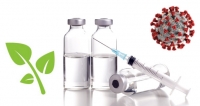Vaccines, Phytonutrients and Coronavirus
As the world’s hopes for the end of the COVID-19 pandemic rely on the new vaccines there are still multiple issues regarding long-term safety of the experimental genetic-based vaccine technology. Currently, between the two available vaccines, from Pfizer/BioNTech and the other from Moderna, both are based on the introduction of a viral messenger RNA (mRNA) into the cells. These vaccines use a synthetic version of the mRNA which a virus uses to build its infectious proteins. The human cells read RNA as instructions to build those virus proteins which then are detected by the immune system and trigger an immune response against the virus. On the other hand, the DNA vaccines (some of which are still in the clinical trials) use weakened viruses, e.g. the modified chimpanzee adenovirus, to transport the coronavirus genes into the human cells, and stimulate the immune response. The vaccines from Johnsons & Johnson, the University of Oxford, and Russia’s Sputnik vaccine are some examples of adenovirus-based DNA vaccines.
The SARS-CoV-2 virus has spikes on its surface that are used to attach to the cells and infect them. These spike proteins play a critical role in the infectivity of the coronavirus by recognizing and binding to a specific place on the cell surface called the angiotensin-converting enzyme 2 (ACE2) receptor to gain entry into the cell. Preventing viral binding by specific antibodies is a major target in the development of vaccines.
While the nucleic acid-based (DNA and RNA) vaccines for other viral infections such as HIV or Ebola have been researched for more than a decade, not a single vaccine was approved due to safety concerns. With rush decisions made due to the current pandemic, only short-term safety aspects could be addressed in clinical trials. As a result, hundreds of millions of vaccinated people all over the world become guinea pigs for this not fully tested technology.
We do not wish to undermine the importance of vaccines in general, however, the efforts to find other safe and effective methods to fight COVID-19 should continue. Our research has shown that a specific combination of micronutrients containing vitamin C, certain minerals, amino acids, and plant extracts, was effective in significantly decreasing the expression of the ACE2 receptor in key types of cells targeted by the SARS-CoV-2. The key cell types are the human lung small airways (alveolar cells) and the endothelial cells lining the blood vessels1. In a follow-up study, we tested the effects of another combination of nutrients and plant extracts (phytonutrients) on key steps in the coronavirus infection2. These steps included blocking the binding of the coronavirus spike protein to the ACE2 receptor on human cells. This is the exact mechanism targeted in vaccines. Our results showed that the phytonutrients could block the attachment of the spike protein to the ACE2 receptors by 97%. In addition, they inhibited the expression of ACE2 receptors on human small alveolar epithelial cells by up to 92%.
With the current almost exclusive focus on the vaccines, it is not only important to increase our understanding of this genetic-based vaccine technology, but also take advantage of research based on proven, safe, and effective natural options. It is plausible that new vaccines could only be effective against a specific virus. However, their efficacy against any mutated viruses, which are already emerging worldwide, is not known. On the other hand, the micronutrients affect general and multiple mechanisms of infection at once and can support the overall immunity needed to fight various pathogens and chronic diseases.
Ref:
1. Ivanov V, et al., J Cell Med & Nat. Health, July 2020.
2. Goc A, et al., J Cell Med & Nat. Health, August 2020.
